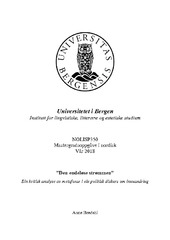"Den endeløse strømmen" Ein kritisk analyse av metaforar i ein politisk diskurs om innvandring
Master thesis
Permanent lenke
https://hdl.handle.net/1956/18279Utgivelsesdato
2018-06-22Metadata
Vis full innførselSamlinger
Sammendrag
Oppgåva undersøker kva for omgrepsmetaforar og metaforiske uttrykk om innvandring, innvandrarar, innvandringspolitikk, Noreg og Europa ein kan finne i eit utvalt materiale. Materialet består av ti tekstar skrivne av politiske aktørar i Noreg. I fem av tekstane blir det argumentert for ein restriktiv innvandringspolitikk i Noreg, og i dei fem andre blir det argumentert for ein meir liberal innvandringspolitikk. I tillegg til å undersøke omgrepsmetaforar og metaforiske uttrykk i tekstane, forsøker oppgåva òg å forklare kva rolle metaforane speler i dei ulike tekstane, for å gi svar på korleis metaforar blir brukt for å skape legitimitet for anten ein restriktiv eller ein liberal innvandringspolitikk i Noreg (eller korleis dei eventuelt blir brukt til å skade legitimiteten til anten ein restriktiv eller ein liberal politikk). Det teoretiske grunnlaget for oppgåva er den kognitive metaforteorien, introdusert av Lakoff og Johnson i 1980, men oppgåva er òg inspirert av meir kritiske metaforforskarar som er opptatt av å kritisk analysere metaforar i autentiske diskursar. Innanfor den kognitive metaforteorien blir metaforar oppfatta som både eit språkleg og eit kognitivt fenomen. Omgrepssystemet vårt er grunnleggande metaforisk, derfor kan metaforane i språket seie noko om korleis vi tenker og forstår dei fenomena vi handsamar metaforisk i språket. Analysen i oppgåva viser at dei aller fleste omgrepsmetaforane og metaforiske uttrykka om innvandring og innvandrarar bidrar til å forme eit negativt bilete av desse to storleikane. Innvandring blir i stor grad oppfatta som noko truande, noko som kan få negative konsekvensar for dei nasjonane som tar imot innvandrarar. I tillegg blir innvandrarar ofte forstått som anna enn menneske, til dømes GODS. I kraft av den negative forståinga kan metaforane om innvandring og innvandrarar vere med å skape legitimitet for ein restriktiv innvandringspolitikk, sidan denne politikken vil gjere at Noreg får færre, eller i alle fall ikkje fleire, innvandrarar i landet. Vidare finst det fleire metaforar som skadar legitimiteten til anten ein restriktiv eller ein liberal innvandringspolitikk, enn metaforar som skapar legitimitet for ein bestemt innvandringspolitikk. Til sist bidrar metaforane om Noreg og Europa anten til å forme eit negativt bilete av innvandring, eller til å kritisere politikk ein ikkje er einig i. The thesis investigates which conceptual metaphors and metaphorical linguistic expressions about immigration, immigrants, immigration policies, Norway and Europe can be found in a selected material. The corpus consists of ten texts written by different political actors in Norway. Five of the texts argue in favor of a restrictive immigration policy in Norway and Europe, while the other five argue in favor of a more liberal view on the issue. The thesis also attempts to explain what role the metaphors play in the different texts, more specifically it tries to explain how the metaphors are used to strengthen legitimacy for either a restrictive or a more liberal immigration policy in Norway (or how they are used to damage the legitimacy for either a restrictive or a more liberal immigration policy). The main theoretical basis for the thesis is Conceptual Metaphor Theory, introduced by Lakoff and Johnson in 1980, but the thesis is also inspired by Critical Metaphor Analysis, which critically examines metaphors in authentic discourses. According to Conceptual Metaphor Theory, metaphors are both a linguistic and a cognitive phenomenon. Our conceptual system is metaphorical in nature, thus the metaphors in our language can inform our way of thinking about and understanding the phenomenon we talk metaphorically about. The thesis shows that the majority of the conceptual metaphors and metaphorical expressions about immigration and immigrants contribute to the shaping of a negative image of immigration and immigrants. Immigration is largely represented as a threat and as something with negative consequences for the nations that receive immigrants. In addition, immigrants are often understood as “things” instead of humans, for example as GOODS. By virtue of this understanding, the metaphors about immigration and immigrants can play an important role in strengthening legitimacy for a restrictive immigration policy, since this policy will make Norway receive less, or at least not more, immigrants. Furthermore, there are more metaphors that damage the legitimacy of either a restrictive or a liberal immigration policy, than there are metaphors that create legitimacy for a specific immigration policy. Lastly, the metaphors about Norway and Europe contribute to a negative understanding of immigration, or to criticism of policy one does not agree with.
